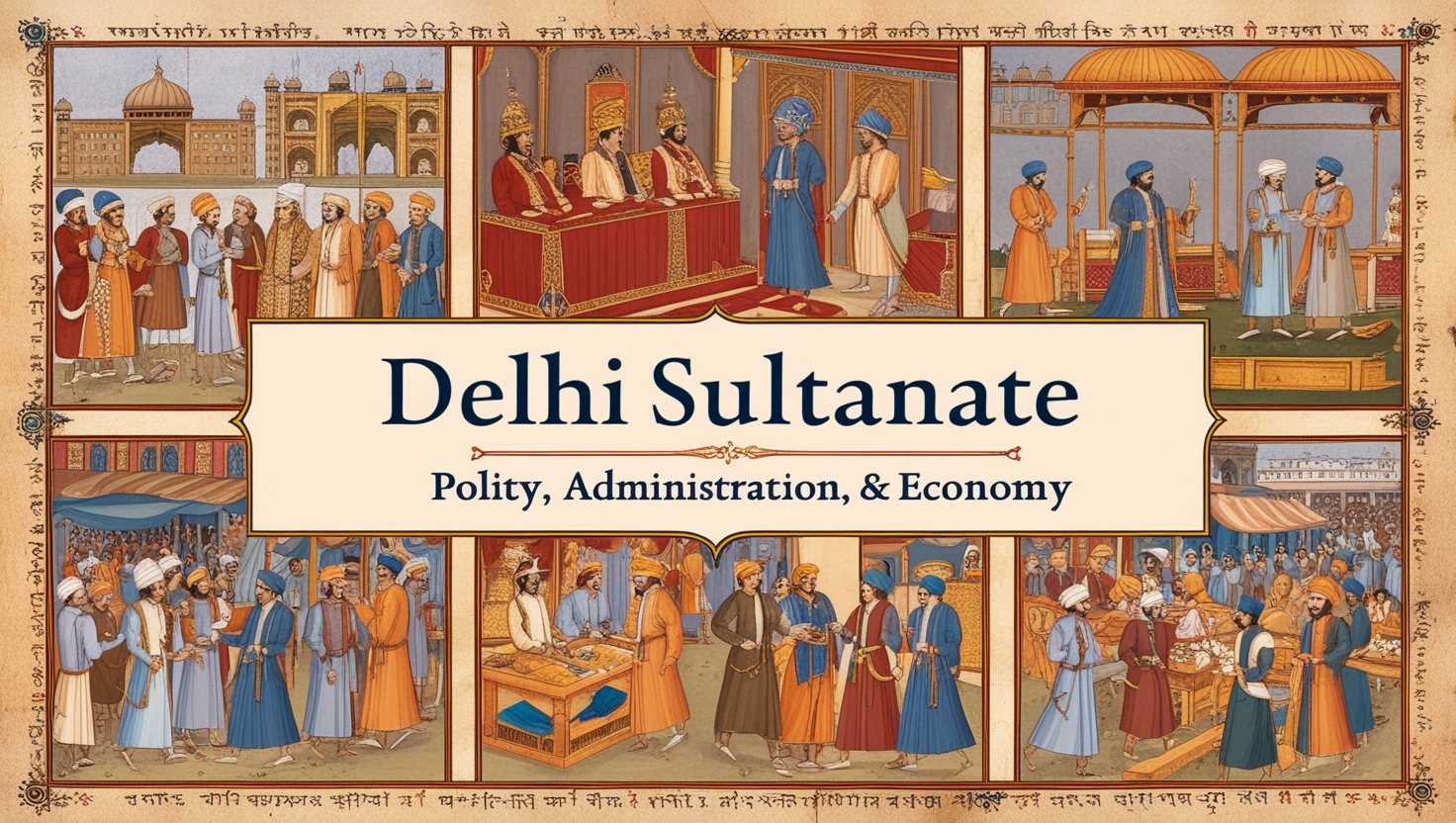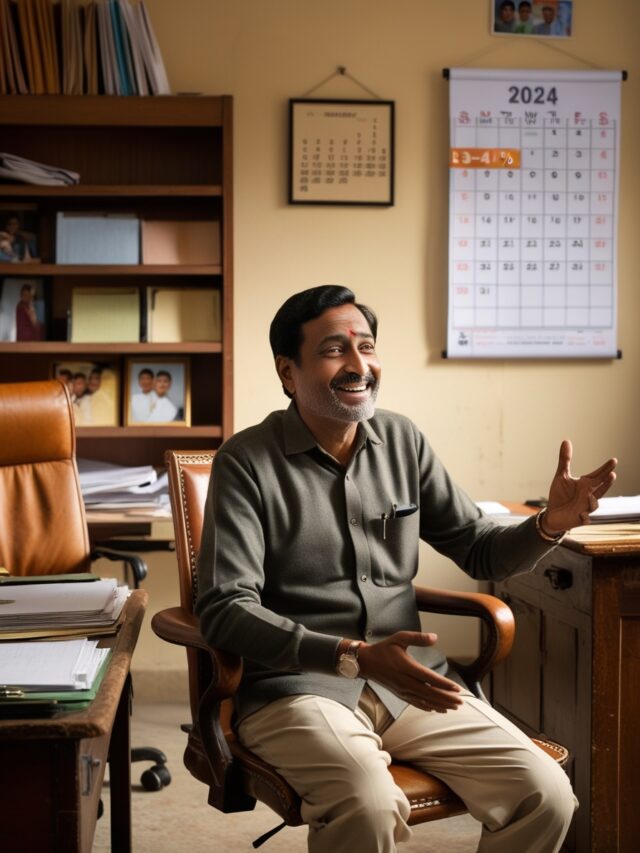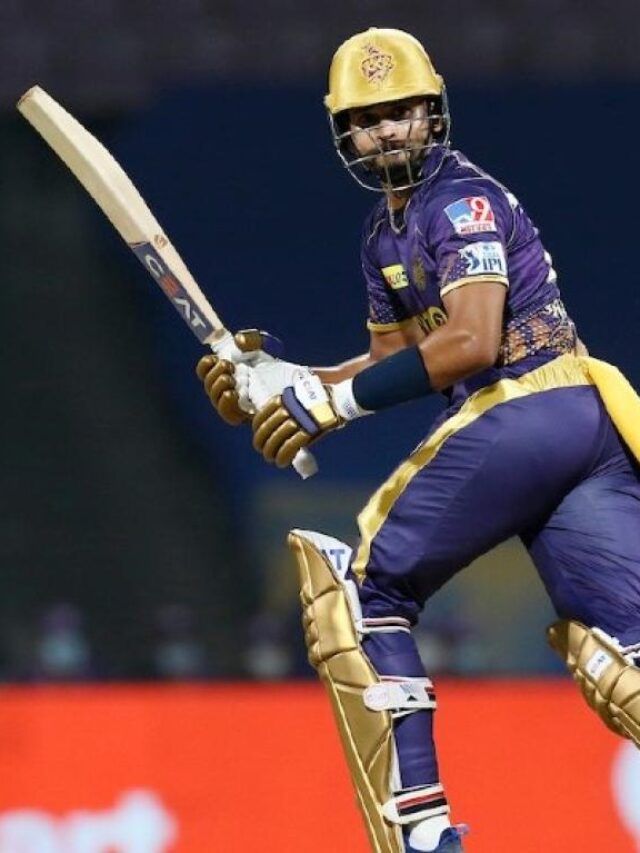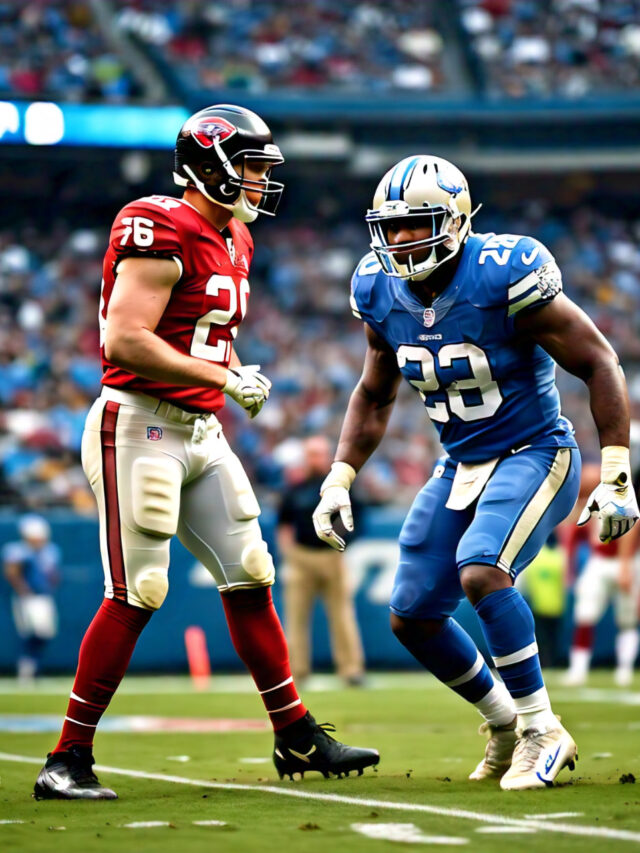
1. The irrigation tax was charged on the farmers for the first time by which among the following Sultans?
- Alauddin Khilji
- Ghiyasuddin Tughlaq
- Mohammad Tughlaq
- Firoz Shah Tughlaq
Show Answer
Answer: Firoz Shah Tughlaq
Firoz Shah Tughlaq, a Sultan of the Delhi Sultanate, is known for introducing the irrigation tax, making him the first ruler to charge farmers for their use of irrigation facilities. This tax aimed to generate revenue for the state and maintain irrigation systems.
2. During the Delhi Sultanate, who among the following were called the Barids?
- Craftsmen
- Bodyguards of the Sultan
- Officer-in-charge of state exchequer
- The spy/news reporters
Show Answer
Answer: The spy/news reporters
The “Barids” served as intelligence agents or spy/news reporters during the Delhi Sultanate. They were responsible for gathering information and reporting it to the Sultan. Their role was crucial in the administration and maintenance of law and order in the empire.
3. Which of the following rulers of the Delhi Sultanate abolished the Iqtas?
- Alauddin Khilji
- Muhammad Tughlaq
- Firozshah Tughlaq
- Balban
Show Answer
Answer: Alauddin Khilji
Alauddin Khilji, during his reign in the Delhi Sultanate, made significant administrative reforms. One of the notable changes he introduced was the abolition of the Iqta system. The Iqta system was a land-grant system for military service, and Alauddin Khilji’s reforms aimed to centralize power and resources.
4. Who was the Sultan of the Delhi Sultanate when Timur invaded India in 1398?
- Mahmud Shah Tughluq
- Jalal ud din Firuz Khilji
- Aram Shah
- Ghiyas-ud-din Balban
Show Answer
Answer: Mahmud Shah Tughluq
Mahmud Shah Tughluq was the Sultan of the Delhi Sultanate during the invasion of India by Timur in 1398. Timur’s invasion had a profound impact on the region, causing destruction and instability in the Sultanate.
5. “Loom” was a central technological innovation in which of the following eras?
- Sultanate Era
- Rajput Era
- Mughal Era
- None of the above
Show Answer
Answer: Sultanate Era
The introduction of the loom, a textile development technology, during the Sultanate Era brought Persian and Central Asian designs into the subcontinent’s textile industry. This technological advancement had a lasting impact on the textile traditions of the region.
6. What was the term used in medieval India for the land directly ruled by the Central Government?
- Muqtis
- Khalisa
- Inam
- None of the above
Show Answer
Answer: Khalisa
The term “Khalisa” referred to the land directly ruled by the Central Government in medieval India. This land was under the direct control of the Sultan or the state, and the revenue generated from it contributed to the state’s finances.
7. That part of the land granted by the sultan to military chiefs for the maintenance of a given number of troopers was called?
- Muahatsib
- Iqta
- Nazir
- Usharaf
Show Answer
Answer: Iqta
“Iqta” was a critical component of the administrative system in the Delhi Sultanate. It represented a portion of land granted by the Sultan to military chiefs in exchange for maintaining troops and providing military service.
8. In the reign of Firuz Shah Tughlaq, which of the following taxes was 1/6 of the booty captured during war?
- Kharaz
- Khams
- Jaqat
- Zaziya
Show Answer
Answer: Khams
“Khams” was a tax introduced by Firoz Shah Tughlaq, representing one-sixth (1/6) of the booty captured during war. This tax revenue contributed to the state treasury and was part of Firoz Shah Tughlaq’s fiscal policies.
9. Which among the following was called the Central Pillar of the administrative system of the Delhi Sultanate?
- Izra system
- Iqta System
- Devsirme system
- Chahalgami
Show Answer
Answer: Iqta System
The Iqta System was considered the central pillar of the administrative system of the Delhi Sultanate.
10. For which purpose did Alauddin Khilji create the “Diwan-i-Riyasat”?
- Revenue Collection
- Civil court
- Tax Control
- To regulate fixed market prices
Show Answer
Answer: To regulate fixed market prices
The “Diwan-i-Riyasat” was established by Alauddin Khilji to control and regulate markets during his reign. This institution played a role in ensuring market stability and preventing exploitation by merchants.
Q11: Who was the first person to introduce Jaziya tax on non-Muslims in India?
1. Mohammd Bin Kasim
2. Mahmud of Ghaznavi
3. Subuktigin
4. Mohammad Ghori
Show Answer
Answer: 1
Explanation: The introduction of the jaziya tax in India is attributed to Umayyad general Muhammad-bin-Qasim in 712 A.D. when he conquered Sind. Jizya was a tax imposed on non-Muslims living in an Islamic state and was a source of revenue for the state.
Q12: With reference to the Sultanate era, the terms amil, karkun, and mutasarrif stand for:
1. Clerks of revenue department
2. Revenue administrator
3. Army soldier
4. Assistant of an army official
Show Answer
Answer: 1
Explanation: During the Sultanate era, terms like amil, karkun, and mutasarrif referred to various clerks within the revenue department. They were responsible for handling revenue-related matters and records.
Q13: Who started the office of Diwan-i-Arz?
1. Raziya
2. Iltutmish
3. Balban
4. Qutubuddin Aibak
Show Answer
Answer: 3
Explanation: Balban established the office of Diwan-i-Arz to manage internal and external disturbances and organize a strong centralized army. This institution played a crucial role in maintaining law and order within the Sultanate.
Q14: During the Delhi Sultanate era, which department was headed by Sadr-us-Sadr?
1. Diwan-i-Mazalim
2. Diwani-Risalat
3. Diwan-i-Riyasat
4. Diwan-i-Insha
Show Answer
Answer: 2
Explanation: Sadr-us-Sadr headed the Diwani-Risalat department, which was responsible for the administration of justice and religious matters. This department played a significant role in maintaining religious and legal order within the Sultanate.
Q15: Which Sultan of Delhi was the first to issue bullion coins with the name of the caliph inscribed on them?
1. Iltutmish
2. Razia
3. Balban
4. Qutubuddin Aibak
Show Answer
Answer: 1
Explanation: Iltutmish, in his quest for legitimacy as a ruler, obtained a letter of investiture from the caliph, which conferred religious authority on him. Additionally, he issued bullion coins with the caliph’s name inscribed on them to reinforce his connection to the religious establishment.
Q16: What was the function of the Khwajas appointed by Balban?
1. For religious matters
2. For estimation of income and expenditure
3. For regulation of the army
4. For judicial purposes
Show Answer
Answer: 2
Explanation: Balban appointed Khwajas to estimate the income of the Iqta holders and the expenses incurred in maintaining their troops. These officials played a vital role in the fiscal and administrative aspects of the Delhi Sultanate.
Q17: Which Delhi Sultan imposed Kharaj-o-Jaziya on non-Muslims for the first time?
1. Firoz Shah
2. Qutubuddin Aibak
3. Akbar
4. Balban
Show Answer
Answer: 2
Explanation: Qutubuddin Aibak imposed the Kharaj-o-Jaziya tax on non-Muslims for the first time during the Delhi Sultanate era. This tax was a source of revenue for the state and marked a significant fiscal policy.
Q18: In the Medieval era, the term Barid stood for?
1. Intelligence Agents
2. Expounder of laws
3. Ministers in charge of the army
4. Head of city administration
Show Answer
Answer: 1
Explanation: Barid referred to the intelligence agents during the medieval era of the Delhi Sultanate.
Q19: Who was the military minister of Balban?
1. Imad-ul-Mulk
2. Mankbarni
3. Aram Khan
4. Mubarak Shah
Show Answer
Answer: 1
Explanation: Balban made Imad-ul-Mulk his military minister, who played a significant role in combating Mongol invasions.
Q20: In the medieval era, the term Mufti stood for which of the following?
1. Supervisor of Bazars
2. Incharge of Army
3. Exponder of law
4. Head of administration
Show Answer
Answer: 3
Explanation: Muftis were Islamic legal authorities who provided formal legal opinions (fatwas) in response to inquiries by individuals or judges.
Q21: In the medieval era, the term kotwal stood for which of the following?
1. Agents of intelligence
2. Head of city administration
3. Chief justice
4. Inspected public eating houses
Show Answer
Answer: 2
Explanation: The Kotwal held the position of the head of city administration during the medieval era, responsible for maintaining law and order in the city. The Kotwal played a vital role in urban governance and security.
Q22: Who introduced the game of polo in India?
1. Unani
2. British
3. Turks
4. Mughal
Show Answer
Answer: 3
Explanation: The Turks introduced the game of polo to India, known as Chaugan. This sport gained popularity during the Delhi Sultanate and later became an important part of Indian sporting culture.
Q23: During the medieval history of India, who were called Dastar-Bandan?
1. Sufi saints
2. Ulema
3. Khan
4. Malik
Show Answer
Answer: 2
Explanation: Dastar-Bandan referred to the honorable ulema or Islamic scholars during the medieval period. They held a respected and significant position in the religious and intellectual life of the Sultanate.
Q24: Which of the following poets of the Persian cult resided in the kingdom of Mahmud?
Unsuri
Faruqi
Asjadi
Choose the right option:
1. Only 1 and 2
2. Only 2 and 3
3. Both 1 and 3
4. All 1,2, and 3
Show Answer
Answer: 4
Explanation: The poets Unsuri, Faruqi, and Asjadi resided in the kingdom of Mahmud of Ghazni.
Q25: The kingdom of Muhammad Ghori included which of the following parts?
Afghanistan
Tajikistan
Turkmenistan
Kazakhstan
Choose the right option:
1. Only 1 and 2
2. Only 3 and 4
3. Both 1 and 3
4. All 1,2, 3, and 4
Show Answer
Answer: 4
Explanation: The kingdom of Muhammad Ghori included parts of Afghanistan, Tajikistan, Turkmenistan, and Kazakhstan.
Q26: Which of the following organized Turkan-i-Chahalgani or the Forty?
1. Qutbuddin Aibak
2. Razia Sultan
3. Nasiruddin Mahmud
4. Iltutmish
Show Answer
Answer: 4
Explanation: Iltutmish organized the Turkan-i-Chahalgani, a new class of ruling elite consisting of forty powerful military leaders who advised and assisted the Sultan in administering the Sultanate.
Q27: Which Sultan of the Mamluk Dynasty was in power for the longest period?
1. Nasiruddin Mahmud
2. Balban
3. Iltutmish
4. Bahram Shah
Show Answer
Answer: 3
Explanation: Iltutmish ruled for the longest period among the mentioned sultans, from 1211 to 1236 (25 years).
Q28: Which of the following department was called Diwan-i-Arz during the reign of Balban?
1. Military Department
2. Foreign Department
3. Finance Department
4. None of the above
Show Answer
Answer: 1
Explanation: Diwan-i-Arz, during the reign of Balban in the Delhi Sultanate, referred to the Military Department. Balban reorganized this department to strengthen the administration and maintain order within the empire. The military department played a crucial role in organizing and maintaining the royal army, conducting army reviews, and overseeing matters related to the military.
Q29: Who was the first Delhi Sultan to collect land revenue in cash?
1. Iltutmish
2. Jalauddin Khalji
3. Alauddin Khalji
4. Balban
Show Answer
Answer: 3
Explanation: Alauddin Khalji was the first Sultan of Delhi to collect land revenue in cash. He introduced measurement of land and fixed the share of the state, ensuring land revenue was collected in cash.
Q30: Which of the following was the first Sultan of Delhi who ordered for the measurement of land?
1. Iltutmish
2. Balban
3. Alauddin Khalji
4. Ghiyasuddin Tughlaq
Show Answer
Answer: 3
Explanation: Alauddin Khalji was the first Sultan of Delhi who ordered for the measurement of land. He implemented land measurement and collected land revenue in cash.
Q31: Which of the following introduced two new coins called Adha and Bitch?
1. Mohammad Bin Tughlaq
2. Firoz Shah Tughlaq
3. Daulat Khan
4. Nasiruddin Muhammad
Show Answer
Answer: 2
Explanation: Firoz Shah Tughlaq, another Sultan of the Delhi Sultanate, introduced two new coins called Adha and Bitch during his rule. These coins represented different fractions of the Jital currency, facilitating transactions and trade within the empire. Firoz Shah Tughlaq implemented various administrative and economic reforms during his reign.
Q32: In the Delhi Sultanate, which of the following practically enjoyed all the powers of the Sultan and exercised general control over all the departments?
1. Naib
2. Wazir
3. Sadr
4. None of the above
Show Answer
Answer: 1
Explanation: In the Delhi Sultanate, the term Naib referred to a significant position with considerable power, practically enjoying all the powers of the Sultan. These officials exercised general control over various departments, which contributed to the functioning and governance of the empire.
Q33: Who headed the finance department called Diwan-i-Wizarat?
1. Naib
2. Wazir
3. Sadr
4. Sultan
Show Answer
Answer: 2
Explanation: The finance department of the Delhi Sultanate was known as Diwan-i-Wizarat, and it was headed by the Wazir. The Wazir’s role was to manage the income and expenditure of the empire, ensuring financial stability and fiscal control.
Q34: With reference to Delhi Sultanate, ‘Diwan-i-Arz’ refers to which of the following?
1. Revenue department
2. Slave department
3. Military department
4. Ceremonies department
Show Answer
Answer: 3
Explanation: Diwan-i-Arz referred to the Military department during the Delhi Sultanate. It was established by Balban.
Q35: Who headed the military department in the Sultanate period?
1. Wazir
2. Ariz-i-mumalik
3. Wakil-i-dar
4. Barid-i-mumalik
Show Answer
Answer: 2
Explanation: The military department, known as Diwan-i-Arz, was headed by Ariz-i-mumalik during the Sultanate period. Their responsibilities included organizing and maintaining the royal army, conducting army reviews, and branding horses.
Q36: Who was the commander-in-chief of the army in the Delhi Sultanate era?
1. Sultan
2. Ariz-i-mumalik
3. Dabir-i-mamalik
4. None of the above
Show Answer
Answer: 1
Explanation: While the Sultan held the position of commander-in-chief of the army in the Delhi Sultanate era, the Ariz-i-mumalik played a critical role in the organization and maintenance of the royal army. They were not the commander-in-chief but held important responsibilities in the military administration.
Q37: Which of the following was Diwan-i-Rasalat during the Delhi Sultanate era?
1. Department of revenue
2. Department of military affairs
3. Department of religious affairs
4. Department of slaves
Show Answer
Answer: 3
Explanation: Diwan-i-Rasalat during the Delhi Sultanate era referred to the department of religious affairs. It managed matters related to pious foundations, grants, and stipends for deserving scholars and people of piety, emphasizing the significance of religious matters within the governance structure.
Q38: Who headed the department of religious affairs during the Delhi Sultanate era?
1. Wazir
2. Sultan
3. Sadr
4. Muhtasib
Show Answer
Answer: 3
Explanation: The department of religious affairs was overseen by the Chief Sadr during the Delhi Sultanate era. The Chief Sadr also served as the Chief Qazi, heading the judicial department and playing a pivotal role in administering justice and religious matters.
Q39: Which of the following statements are correct regarding the judicial system during the Sultanate period?
1) Chief Qazi was the head of the judicial department.
2) Muslim personal law or Sharia was followed in civil matters.
3) Hindus were governed by their own personal law, and their cases were dispensed by the village panchayats.
Choose the right option:
1. Only 1 and 2
2. Only 2 and 3
3. Both 1 and 3
4. All 1,2, and 3
Show Answer
Answer: 4
Explanation: All three statements are correct. The Chief Qazi headed the judicial department, Muslim personal law (Sharia) was followed in civil matters, and Hindus were governed by their own personal law, with their cases being handled by village panchayats.
Q40: During the Delhi Sultanate era, what was the department of correspondence called?
1. Diwan-i-Rasalat
2. Diwan-i-Insha
3. Diwan-i-Arz
4. Diwan-i-Wizarat
Show Answer
Answer: 2
Explanation: The department of correspondence, called Diwan-i-Insha, was responsible for handling all official correspondence between the Sultan and sovereigns of other states, as well as interactions with subordinate officials. This department played a crucial role in diplomatic relations and communication.
Q41: What were the provinces under the Delhi Sultanate called?
1. Shiqs
2. Iqtas
3. Pargana
4. None of the above
Show Answer
Answer: 2
Explanation: Provinces in the Delhi Sultanate were known as Iqtas and were initially under the control of the nobles. These divisions of land facilitated effective administration and revenue collection.
Q42: In the Sultanate period, what were the governors of the provinces called?
1. Muqtis
2. Shiqdar
3. Amil
4. Patwari
Show Answer
Answer: 1
Explanation: The governors of the provinces in the Sultanate period were referred to as Muqtis or Walis. They held authority over their respective provinces, managing law and order and collecting land revenue to support the state’s finances.
Q43: During the Sultanate period, the provinces were further divided into what?
1. Iqtas
2. Shiqs
3. Pargana
4. Village
Show Answer
Answer: 2
Explanation: In the Sultanate period, provinces were further subdivided into Shiqs, which were under the control of the Shiqdar. The Shiqdar served as the executive head responsible for maintaining law and order within these smaller regions.
Q44: The Shiqs were divided into which of the following during the Sultanate period?
1. Iqtas
2. Bhukti
3. Pargana
4. None of the above
Show Answer
Answer: 3
Explanation: The provinces of the Iqtas during the Sultanate period were further divided into Shiqs, which were subsequently divided into parganas consisting of multiple villages. The Amil was the official in charge of the pargana, responsible for local administration.
Q45: Who headed the ‘pargana’ in the Sultanate period?
1. Walis
2. Shiqdar
3. Bhukti
4. Amil
Show Answer
Answer: 4
Explanation: In the Sultanate period, the provinces were divided into shiqs, which were further divided into parganas comprising a number of villages. The pargana was headed by an official known as the Amil.
Q46: During the Sultanate period, the village headman was known as?
1. Amil
2. Gaulmika
3. Bhukti
4. Muqaddam
Show Answer
Answer: 4
Explanation: The village headman during the Sultanate period was known as the muqaddam or Chaudhri. The muqaddam played a crucial role in the administration of the village, managing local affairs and serving as a representative of the authorities.
Q47: During the Sultanate period, the village accountant was known as?
1. Patwari
2. Wazir
3. Naib
4. Sadr
Show Answer
Answer: 1
Explanation: The village accountant during the Sultanate period was referred to as the patwari. The patwari held responsibilities for maintaining land records, collecting land revenue, and assisting with financial matters at the village level.
Q48: Musttauf-i-mumalik during the Sultanate period refers to what of the followings?
1. Priest
2. Auditor General
3. Local officer
4. Tax officer
Show Answer
Answer: 2
Explanation: The Musttauf-i-mumalik was the auditor general during the Sultanate period. This official had the essential role of auditing accounts and overseeing financial matters to ensure financial transparency and accountability within the state.
Q49: Munshi-i-mumalik dealt with which of the following matters during the Sultanate period?
1. Postal correspondence
2. Religious affairs
3. Revenue affairs
4. Maintaining court decorum
Show Answer
Answer: 1
Explanation: The Munshi-i-mumalik was responsible for handling all postal correspondence on behalf of the state during the Sultanate period. To facilitate communication, groups of horsemen or runners were appointed to carry official correspondence throughout the kingdom, ensuring effective communication across the empire.
Q50: What was the function of ‘wakil-i-dar’ during the Sultanate period?
1. Maintaining court decorum
2. Maintaining law and order
3. Taking care of religious matters
4. None of the above
Show Answer
Answer: 1
Explanation: The ‘wakil-i-dar’ during the Sultanate period played a significant role in maintaining court decorum. They were responsible for overseeing the seating arrangement of nobles at the royal court and ensuring that proper conduct and etiquette were observed during court proceedings. This role helped in maintaining the dignity and order within the court.
Q51: Which of the following are the main functions performed by the iqtadars during the Sultanate period?
1) Collection of land revenue.
2) Maintenance of law and order.
Choose the right option:
1. Only 1 and 2
2. Only 2 and 3
3. Both 1 and 3
4. none of the above
Show Answer
Answer: 1
Explanation: Iqtadars, who were the heads of iqtas, had primary functions that included collecting land revenue and maintaining law and order in the regions assigned to them. Iqtas were revenue assignments granted by the Sultan, and the iqtadars were tasked with efficient revenue collection and local administration. These officials played a crucial role in ensuring financial stability and governance within their respective areas.
Q52: Which of the following statements are correct regarding iqtadars?
1) They were granted the iqtas on a temporary basis.
2) Iqtadars could be transferred within the Kingdom.
3) Iqtadars were the owners of the land assigned to them.
Choose the right option:
1. Only 1 and 2
2. Only 2 and 3
3. Both 1 and 3
4. all 1,2, and 3
Show Answer
Answer: 1
Explanation: The correct statements are 1 and 2. Iqtadars were granted the iqtas on a temporary basis, and they could be transferred within the Kingdom. However, they were not the owners of the land assigned to them.
Q53: During the Sultanate era, ‘Khuts’ referred to which of the following?
1. Slaves
2. Village headmen
3. Land Owners
4. Labourers
Show Answer
Answer: 3
Explanation: In the Sultanate period, the term ‘khuts’ referred to landowners who owned and cultivated the land in the villages. They were essential figures responsible for the agricultural production in their areas. The village headman during this period was known as the muqaddam, and they held a distinct role in village administration.
Q54: During the Delhi Sultanate era, what was the Takkavi loan?
1. Loan for marriage
2. Loan for cultivation
3. Loan for irrigation
4. None of the above
Show Answer
Answer: 2
Explanation: During the Delhi Sultanate era, the Takkavi loan, also known as Taccavi or Takavi, was a type of loan extended by the state to the peasants or farmers to help them during times of agricultural distress. It was primarily an agricultural loan provided to support the agricultural sector, especially during periods of drought, floods, or other natural calamities that might have affected crop yields or farmers’ ability to repay their taxes.
Q55: Which sultan of the Delhi Sultanate created a separate agricultural department called Diwan-i-Kohi?
1. Iltutmish
2. Balban
3. Muhammad bin Tughlaq
4. Firoz Tughlaq
Show Answer
Answer: 3
Explanation: The Diwan-i-Kohi, a separate agricultural department, was created by Sultan Muhammad bin Tughlaq during the Tughlaq dynasty’s rule in the Delhi Sultanate. Muhammad bin Tughlaq reigned from 1325 to 1351 and introduced several administrative and economic reforms during his rule, including the establishment of the Diwan-i-Kohi to oversee agricultural matters. Thank you for pointing out the correction.
Q56: Cambay in Gujarat was famous for which of the following during the Sultanate period?
1) Textiles
2) Gold and silver work
3) Muslin
Choose the right option:
1. Only 1
2. Only 2 and 3
3. Both 1 and 2
4. all 1,2, and 3
Show Answer
Answer: 3
Explanation: Cambay in Gujarat was famous for the following during the Sultanate period:
Textiles
Gold and silver work
Bengal was famous for muslin.
Q57: India imported which of the following from West Asia during the Sultanate period?
1) High-grade textiles
2) Glassware
3) Horses
Choose the right option:
1. Only 1 and 2
2. Only 2 and 3
3. Both 1 and 3
4. all 1,2, and 3
Show Answer
Answer: 4
Explanation: India imported the following from West Asia during the Sultanate period:
High-grade textiles
Glassware
Horses
All of the options listed were imported from West Asia during this period.
Q58: During the Sultanate period, India imported raw silk and porcelain from which of the following regions?
1. West Asia
2. Persian Gulf Region
3. China
4. Europe
Show Answer
Answer: 3
Explanation: During the Sultanate period in India, raw silk and porcelain were imported from regions such as China and Central Asia. China was particularly renowned for its production of porcelain, and these imported Chinese porcelain items were highly valued in India during that time. Raw silk, which was used for making fine textiles, was also imported from regions like China and Central Asia, where sericulture and silk production were well-established.
Q59: Which of the following was not a dominating community in Inland trade during the Sultanate period?
1. Gujarati
2. Marwari
3. Muslim Bohra merchants
4. Khurasanis
Show Answer
Answer: 3
Explanation: During the Sultanate period in India, the Khurasanis were not a dominating community in inland trade. The other groups mentioned – Gujarati, Marwari, and Muslim Bohra merchants – were known for their significant involvement in trade and commerce during this time. Khurasanis, referring to people from the region of Khurasan (which includes parts of modern-day Iran, Afghanistan, and Central Asia), were not as prominent in the inland trade networks of India during the Sultanate period.
Q60: Which of the following statements are correct with respect to the period of the Delhi Sultanate?
1) Cotton textile and silk industry flourished in this period.
2) Sericulture was introduced on a large scale.
3) There was extensive use of paper from the 14th and 15th centuries.
Choose the right option:
1. Only 1 and 2
2. Only 2 and 3
3. Both 1 and 3
4. all 1,2, and 3
Show Answer
Answer: 3
Explanation: The correct statements regarding the period of the Delhi Sultanate are:
Cotton textile and silk industry flourished in this period.
There was extensive use of paper from the 14th and 15th centuries.
Statement 2 is not accurate. Sericulture, the cultivation of silkworms for silk production, was known in India well before the Delhi Sultanate period, and it did not need to be introduced on a large scale during this time as it was already practiced in various regions.
Q61: Gold coins or dinars became popular during the reign of which Sultan of the Delhi Sultanate?
1. Jalaluddin Khalji
2. Alauddin Khalji
3. Aurangzeb
4. Firoz Shah Tughlaq
Show Answer
Answer: 2
Explanation: Gold coins or dinars became popular during the reign of Alauddin Khilji, who was the second ruler of the Khilji dynasty and reigned as the Sultan of Delhi from 1296 to 1316. Alauddin Khilji introduced several economic and fiscal reforms, including the standardization of currency, which helped popularize gold dinars as a form of currency during his rule. These gold dinars were widely used for trade and commerce in the Delhi Sultanate.
Q62: Which of the following regions was famous for raw silk and muslin during the Sultanate period?
1. Multan
2. Anhilwara
3. Kambath
4. Sonargaon
Show Answer
Answer: 4
Explanation: During the Sultanate period in India, the region famous for the production of raw silk and muslin was Sonargaon. Sonargaon, which is located in present-day Bangladesh, was particularly renowned for its high-quality muslin fabric, known for its fine texture and lightness. This region was a significant center for the production and trade of muslin during that time.
Q63: The term ‘hundis’ during the Sultanate era refers to which of the following?
1. Paper money
2. Bills of exchange
3. Barter exchange
4. None of the above
Show Answer
Answer: 2
Explanation: The term hundis during the Sultanate era in India refers to financial instruments or promissory notes that were used for trade and credit purposes. These hundis were essentially written orders of payment and served as a form of early banking or bill of exchange. They were widely used in the medieval Indian economy and provided a way for merchants, traders, and others to transfer money or credit over long distances without physically moving large sums of currency.
Hundis were used for various financial transactions, including trade, remittances, and the transfer of funds from one location to another. They helped facilitate commerce and finance during the Sultanate era and were an important feature of the economic landscape of that time.
Q64: Which ministry was the military department in the Delhi Sultanate administration?
1. Controller-general of BREY
2. Diwan-I-Risalt
3. Diwan-Ariz
4. Diwan-I-Insha
Show Answer
Answer: 3
Explanation: In the Delhi Sultanate administration, the military department, responsible for overseeing the military and defense affairs, was known as the Diwan-i-Arz. The Diwan-i-Arz played a central role in managing the military forces, their organization, equipment, and related administrative matters.
The head of the Diwan-i-Arz was called the Mir-i-Arz, who was a high-ranking military official responsible for matters like recruitment, training, deployment, and the overall administration of the army. The Diwan-i-Arz worked in close coordination with the Sultan and other high-ranking officials to ensure the security and defense of the Delhi Sultanate’s territories. It played a crucial role in the functioning of the state and the Sultanate’s ability to defend its realm.
Q65: Which was the ministry of foreign affairs in the Delhi Sultanate administration?
1. Diwan-I-Barid
2. Diwan-I-Saman
3. Diwan-I-Risalt
4. Diwan-i-Wazarat
Show Answer
Answer: 3
Explanation:
During the Delhi Sultanate period, the ministry responsible for foreign affairs and diplomatic relations was known as the Diwan-i-Risalat. The Diwan-i-Risalat was the department or office in charge of handling diplomatic correspondence, foreign envoys, treaties, and other matters related to external relations and foreign policy. It played a crucial role in managing the Sultanate’s relationships with other states, including neighboring Indian kingdoms and empires, as well as foreign powers beyond the Indian subcontinent.
Q66: In the Delhi Sultanate, who was the head of the religious department?
1. Diwan-I-Insha
2. Sadr-Ur-Sadar
3. Diwan-i-Bayutat
4. Qazi-ul-Quzat
Show Answer
Answer: 2
Explanation: In the Delhi Sultanate, the head of the religious department and a prominent religious official was the Sadr-i-Sadur. The Sadr-i-Sadur was responsible for overseeing religious matters, including the administration of religious endowments, patronage of religious institutions, and the appointment of religious scholars and officials. They played a crucial role in maintaining the relationship between the state and the religious establishment, which was often closely intertwined with the governance of the time. The Sadr-i-Sadur held a position of great significance in the Delhi Sultanate, and their role was integral in the administration of religious affairs in the state.
Q67: In the Delhi Sultanate, who was in charge of local correspondence and various offices?
1. Mustauf-i-Mumalik
2. Shiqdar
3. Diwan-I-Insha
4. Muqaddam
Show Answer
Answer: 3
Explanation: Diwan-I-Insha was the ministry responsible for managing local correspondence and various offices during the Sultanate era. It played a key role in handling internal communications, official correspondences, and local administrative matters.
Q68: Who was first to introduce the Iqta system in India?
1. Qutb al-Din Aibak
2. Iltutmish
3. Muhammad Ghori
4. Ibrahim Lodhi
Show Answer
Answer: 2
Explanation: Muhammad Ghori introduced the Iqta system in India in 1206 AD, but it was Iltutmish who gave it an institutional form. Qutbuddin Aibak was assigned as the first iqta holder in India by Muhammad Ghori. The Iqta system was a significant development in the administrative structure of the Delhi Sultanate, allowing for efficient revenue collection and regional governance.
Q69: Which officers collected land revenue and other taxes under the Delhi Sultanate?
1. Mushrif
2. Faujdar
3. Qazi
4. Amil
Show Answer
Answer: 4
Explanation: Amils were officers responsible for collecting land revenue and other taxes under the Delhi Sultanate. They played a crucial role in the fiscal administration of the Sultanate by ensuring the collection of revenue from various regions.
Q70: Which of the following was the department of arrears in the Delhi Sultanate?
1. Diwan-i-Khairat
2. Diwan-i-Insha
3. Diwan-i-Mustakhraj
4. None of the above
Show Answer
Answer: 3
Explanation: Diwan-I-Mustakhraj was introduced by Alauddin Khilji in the Delhi Sultanate. It was the department responsible for dealing with arrears, focusing on the recovery of unpaid revenues, and maintaining financial discipline.
Q71: Which of the following was the department of charity under the Delhi Sultanate?
1. Majlis-i-am
2. Barid-i-Mumalik
3. Dahir-i-mumalik
4. Diwan-i-Khairat
Show Answer
Answer: 4
Explanation: Diwan-I-Khairat was the department of charity in the Delhi Sultanate administration. It was responsible for managing and distributing charitable contributions for the welfare of the less fortunate and various social needs.
Q72: Who was the head of the department of Diwan-i-Insha under the Delhi Sultanate?
1. Sadr-i-jahan
2. Davir-i-Khas
3. Amir-i-dad
4. Sadr-us-sudur
Show Answer
Answer: 2
Explanation: The head of the department of Diwan-I-Insha was known as Davir-I-Khas (Amir-Munshi). This official was responsible for conducting formal or confidential correspondence between the Sultan and other states’ rulers, subordinate chiefs, governors, and officials. The department was staffed with dabirs (writers) to assist in these diplomatic communications.
Q73: What was the name of the land tax charged from non-Muslims by the Delhi Sultanate?
1. Jizya
2. Khams
3. Kharaj
4. Zakat
Show Answer
Answer: 3
Explanation: Under the Delhi Sultanate, Kharaj was a property tax that was applied to non-Muslims and ranged from 1/3 to 1/2 of the products.
Q74: What was the number of categories of Jizya taxpayers during the Delhi Sultanate period?
1. Two
2. Three
3. Five
4. Six
Show Answer
Answer: 2
Explanation: Jizya was a religious tax for non-Muslims. Non-Muslims were divided into three classes to pay this tax. The first class paid 48 dirhams, the second paid 24 dirhams, and the third paid 12 dirhams per year. Women, children, beggars, the crippled, the blind, the elderly, monks, priests, Brahmins (except in the time of Firuz Tughluq), and all who did not have a source of income were exempt from this tax.
Q75: What was the name of the tax, under the Delhi Sultanate, which was only imposed on rich Muslims?
1. Ushr
2. Zakat
3. Khams
4. None of the above
Show Answer
Answer: 2
Explanation: Zakat was a religious tax that applied only to wealthy Muslims and accounted for 2½ percent of their income.
Q76: Which officer in the Delhi Sultanate looked after the working of wali or muqti?
1. Khwaja
2. Muqaddams
3. Patwari
4. Amil
Show Answer
Answer: 1
Explanation: The central government appointed Amils as revenue collectors in different subdivisions called shiqs. These officials were responsible for collecting revenues with the assistance of hereditary village officials like Chaudharis, Muqaddams, Patwaris, etc. This administrative structure helped manage local revenue collection efficiently.
Q77: Who was the most important officer in the household of the Delhi Sultanate?
1. Amir Hajib
2. Barid-i-Mumalik
3. Diwan-i-amirat
4. Wakil-i-dar
Show Answer
Answer: 4
Explanation: Wakil-i-dar was a crucial official in the Delhi Sultanate responsible for supervising court finances, disbursing allowances and salaries to the ruler’s personal staff, and overseeing the education of the princes. This role ensured the efficient functioning of the royal household and financial matters.
Q78: Under the Delhi Sultanate, which officer was the master of ceremonies at the court?
1. Amir Hajib
2. Naib
3. Wazir
4. None of the above
Show Answer
Answer: 1
Explanation: Amir Hajib, also known as Barbek, was a high-ranking official associated with the court and royal house during the Delhi Sultanate. He served as the master of ceremonies at the court, organized nobles based on their ranks, and played a significant role in presenting petitions to the Sultan, making this post highly important in court proceedings.
Q79: Other than Sonargaon and Satgaon, what was the third administrative division of Bengal during medieval India?
1. Birati
2. Lakhnauti
3. Panchimgaon
4. Gauda
Show Answer
answeAnswer: 2
Explanation: Alauddin Khilji attempted to maintain control over Bengal by dividing it into three administrative divisions, each with its capital, including Lakhnauti (North Bengal), Sonargaon (East Bengal), and Satgaon (South Bengal). However, these measures were not entirely successful in ensuring loyalty to the Delhi Sultanate.r
Q80: Under the Delhi Sultanate administration, which was the department of slaves?
1. Diwan-i-Ishtiaq
2. Diwan-i-Bandagan
3. Diwan-i-Mustakhraj
4. Diwan-i-Kohi
Show Answer
Answer: 2
Explanation: Diwan-i-Bandagan was the department responsible for managing slaves under the Delhi Sultanate, while Diwan-i-Kohi was the agriculture department responsible for overseeing agricultural matters and practices in the Sultanate. These departments played essential roles in the administration of the Sultanate, managing issues related to slavery and agricultural development.
Q81: Which of the following was the agriculture department under the Delhi Sultanate?
1. Diwan-i-Kohi
2. Diwan-i-Khairat
3. Diwan-i-Ishtiaq
4. Diwan-i-arz
Show Answer
Answer: 1
Explanation: Under the Delhi Sultanate administration, Diwan-i-Kohi was the department that was set up to look after agriculture. It was the agriculture department of the sultanate.








Leave a Reply